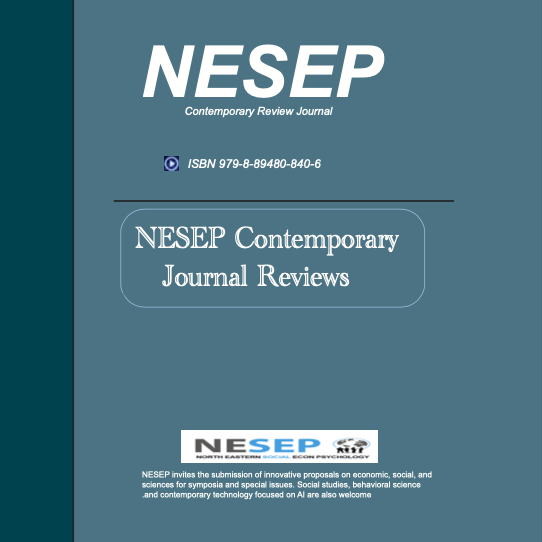Featured Issues
Below are compilations of selected work related to a contemporary matter area.

Palma, Spain. 6/30~7/2, 2025.
ISBN 2: 979-8-89480-848-2
Annual Conference
Publisher: NESEP
Investigating the Role of Astrocyte Aneuploidy and Senescence in Glioblastoma Development
Abstract:
Glioblastoma is an aggressive brain cancer with high resistance to conventional therapies, killing 200,000 worldwide every year. Aneuploidy, the disbalance of chromosomal counts, is considered a significant development agent, being characterized in 90% of solid tumors and commonly regulated by the BUB1 and SMC1A genes. Understanding the biological pathways that drive tumor development and resistance becomes paramount in developing effective treatments. Thus, the following study investigated the genetic suppression of BUB1 and SMC1A in astrocytes to determine if aneuploidy could be induced. Human brain tissue samples of both healthy and patients with glioblastoma obtained underwent fluorescence-activated cell sorting for astrocyte isolation. To investigate aneuploid patterns, the study employed single-cell whole-genome sequencing, interphase Fluorescence In Situ Hybridization (FISH), and RNAscope to quantify chromosomal copy number alterations and aneuploidy frequencies. Additionally, in-vitro cell culturing experiments involving lentivirus-induced knockdown of BUB1 and SMC1A genes provided insights into gene expression changes, affirming the creation of an aneuploidic environment in astrocytes. The study identified large aneuploid frequencies in glioblastoma inflicted brain samples and significant knockdown of BUB1 and SMC1A (p<0.05), creating an pro-aneuploidic environment that can further be observed to identify the senescence associated secretory phenotype. Altogether, the study provides validation of significant gene knockdown and the establishment of a framework to explore potential therapeutic strategies for aggressive brain cancers like glioblastoma.
References
1. Mohammed, S., Dinesan, M., & Ajayakumar, T. (2022). Survival and quality of life analysis in
glioblastoma multiforme with adjuvant chemoradiotherapy: a retrospective study. Reports of
practical oncology and radiotherapy : journal of Greater Poland Cancer Center in Poznan and
Polish Society of Radiation Oncology, 27(6), 1026–1036.
https://doi.org/10.5603/RPOR.a2022.0113
2. Tamimi, A. F., & Juweid, M. (2017). Epidemiology and Outcome of Glioblastoma. In S. De
Vleeschouwer (Ed.), Glioblastoma. Codon Publications.
3. Roda, D., Veiga, P., Melo, J. B., Carreira, I. M., & Ribeiro, I. P. (2024). Principles in the
management of glioblastoma. Genes, 15(4), 501. https://doi.org/10.3390/genes15040501
4. Wu, W., Klockow, J. L., Zhang, M., Lafortune, F., Chang, E., Jin, L., Wu, Y., & Daldrup-Link,
H. E. (2021). Glioblastoma multiforme (GBM): An overview of current therapies and
mechanisms of resistance. Pharmacological research, 171, 105780.
https://doi.org/10.1016/j.phrs.2021.105780
5. Shahcheraghi, S. H., Alimardani, M., Lotfi, M., Lotfi, M., Uversky, V. N., Guetchueng, S. T.,
Palakurthi, S. S., Charbe, N. B., Hromić-Jahjefendić, A., Aljabali, A. A., Gadewar, M. M., Malik, S.,
Goyal, R., El-Tanani, M., Mishra, V., Mishra, Y., & Tambuwala, M. M. (2024). Advances in
Glioblastoma Multiforme: Integrating therapy and Pathology perspectives. Pathology, Research
and Practice, 257, 155285. https://doi.org/10.1016/j.prp.2024.155285
6. Rikan, S. B., Azar, A. S., Naemi, A., Mohasefi, J. B., Pirnejad, H., & Will, U. K. (2024). Survival
prediction of glioblastoma patients using modern deep learning and machine learning techniques.
Scientific Reports, 14(1). https://doi.org/10.1038/s41598-024-53006-2
7. Shergalis, A., Bankhead, A., 3rd, Luesakul, U., Muangsin, N., & Neamati, N. (2018). Current
Challenges and Opportunities in Treating Glioblastoma. Pharmacological reviews, 70(3),
412–445. https://doi.org/10.1124/pr.117.014944
8. Lara-Velazquez M, Al-Kharboosh R, Jeanneret S, et al. Advances in Brain Tumor Surgery for
Glioblastoma in Adults. Brain Sci. 2017;7(12):166. Published 2017 Dec 20.
doi:10.3390/brainsci7120166
9. Ali, Y., Oliva, C. R., Noman, A. S. M., Allen, B. G., Goswami, P. C., Zakharia, Y., Monga, V., Spitz,
D. R., Buatti, J. M., & Griguer, C. E. (2020). Radioresistance in glioblastoma and the development
of radiosensitizers. Cancers, 12(9), 2511. https://doi.org/10.3390/cancers12092511
10. Sebastian, E., Cui, T., Bell, E., McElroy, J., Johnson, B., Gulati, P., Geurts, M., Becker, A.,
Fleming, J., Haque, S., Robe, P., & Chakravarti, A. (2020). Characterization of a novel
MIR-4516-PTPN14 therapeutic resistance pathway induced by radiation treatment in
glioblastoma. International Journal of Radiation Oncology, Biology, Physics, 108(3), e572.
https://doi.org/10.1016/j.ijrobp.2020.07.1761
11. Ou, A., Yung, W. K. A., & Majd, N. (2020). Molecular Mechanisms of Treatment Resistance in
Glioblastoma. International journal of molecular sciences, 22(1), 351.
https://doi.org/10.3390/ijms22010351
12. Jackson, C. M., Choi, J., & Lim, M. (2019). Mechanisms of immunotherapy resistance: lessons
from glioblastoma. Nature Immunology, 20(9), 1100–1109.
https://doi.org/10.1038/s41590-019-0433-y
13. White, J., White, M. P. J., Wickremesekera, A., Peng, L., & Gray, C. (2024). The tumor
microenvironment, treatment resistance and recurrence in glioblastoma. Journal of Translational
Medicine, 22(1).
https://doi.org/10.1186/s12967-024-05301-9https://doi.org/10.1038/s41392-021-00499-2
14. Lai, Y., Lu, X., Liao, Y., Ouyang, P., Wang, H., Zhang, X., Huang, G., Qi, S., & Li, Y. (2023).
Crosstalk between glioblastoma and tumor microenvironment drives proneural-mesenchymal
transition through ligand-receptor interactions. Genes & diseases, 11(2), 874–889.
https://doi.org/10.1016/j.gendis.2023.05.025
15. Inda, M. M., Bonavia, R., & Seoane, J. (2014). Glioblastoma multiforme: a look inside its
heterogeneous nature. Cancers, 6(1), 226–239. https://doi.org/10.3390/cancers6010226
16. Verdugo, E., Puerto, I., & Medina, M. Á. (2022). An update on the molecular biology of
glioblastoma, with clinical implications and progress in its treatment. Cancer communications
(London, England), 42(11), 1083–1111. https://doi.org/10.1002/cac2.12361